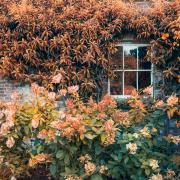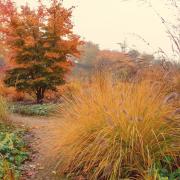Indian Summer in the garden.
The ‘season of mists and mellow fruitfulness’ is coming up and the garden has a more sedate feel after the lushness of summer. This time of year provokes a mix of joy and ruefulness with some fantastic colour; dew-jewelled spider webs appearing from the trees and shrubs; but with the precedence of the cooler weather that’s coming. If we are lucky this year, we are in for an Indian summer, when the weather stays fair and warm to match the colours of the autumn. Hot pink dahlias, terracotta achillea, and bright orange echinacea jostle for attention in borders and autumn containers. However, I want to focus on some little alpine bulbs that you can plant now to give some superb accents of colour.
Crocus sativus (saffron) Colchicum, Sternbergia and Acis autumnalis, are small, beautiful bulbs that can be planted in September then burst into clumps of jewel like flowers. Saffron has been grown in the UK since the 12th century and is highly prized for its bright orange stigmas in the middle of the lilac, crocus-like flowers. They are handpicked from the flower and then used as a spice and colourant in cooking. However bear in mind, 150 flowers are needed to produce 1 gram of culinary saffron stigmas. Its dried weight is a quarter of its picked weight making it one of the most expensive spices in the world. However, used in autumn flowering containers, alpine troughs, and sunny well drained borders under other taller autumn plants, it looks great. Use it next to bright orange dahlias such as ‘David Howard’ which picks up its vibrant orange stigma.
Colchicums are commonly known as ‘naked boys’ because their flowers rise up in September and October though the leaves don’t appear until the new year. The plants grow under deciduous shrubs and leaf up in the early spring to grab the available light. Different varieties offer varied flower shapes, and my favourites are the ‘waterlily’ varieties in soft pink and pure white.
Sternbergia and Acis are more difficult to get hold of, but well worth growing in very gritty well drained sunny spots in either terracotta pots or alpine planters. Sterbergia have vibrant yellow crocus-type flowers from mid-September to the end of October. Acis flower at the same time and look like miniature snowdrops, but the grasslike foliage is deep purple or black. Both are prized amongst alpine growers for autumnal colour. Look out for the northern autumn alpine shows around Yorkshire in October for more inspiration.

Garden of the month
Wynyard Hall Gardens. Technically this garden sits just outside of the border of North Yorkshire on the edge of Hartlepool. It is well worth the effort to drive up the A19 past Middlesborough to get there. In September the garden is full of the second flush of flowers on the 3000+ David Austin English rose collection that is planted in the gorgeous wall garden. It is great garden to show how roses and other shrubs and perennials can be grown together. What I’m really impressed with is the roses are numbered by variety and there is a plan that you can carry round with you so you can identify any that you might want to grow in your own garden. Using this I have chosen to grow ‘The Generous Gardener’ a lovely pink climbing variety and ‘The Shepherdess’ which is a pale apricot bush rose that can be grown in a large container.
There is also a beautifully kept kitchen garden that supplies the lovely Glass House restaurant that sits at the side of it. Locally produced ingredients with their homegrown produce feature heavily on the menu. Literally from plot to plate!
Plant of the month
Ceratostigma plumbaginoides, the hardy plumbago is a must have in your September garden. Clusters of vivid blue flowers are carried at the tips of red stems in September and October. As the light levels start to fall and the temperatures drop overnight, the green leaves turn a beautiful mahogany red, making the blue flowers stand out even more. Grow over the edge of large containers or at the front of a sunny border to get the most from this lovely autumn perennial.

Question time
What can I grow now in my unheated greenhouse that I can harvest over Christmas and new year? After I harvest my tomatoes I have space during the winter before I start sowing my spring crops.
This is a great question. I feel that a lot of people will wonder the same. With the falling light levels and temperatures, an unheated greenhouse or plastic grow house is a real asset for growing winter hardy salad leaves and starting off hardy annuals and hardy vegetable seeds and bulbs. Firstly, the salad crops. Pak choi, winter purslane, Lamb’s lettuce, mustard leaves, mixed Oriental greens, Mizuna, and rocket can all be sown in September and cropped over late autumn and into winter. All these need a little protection from the vagaries of the weather, but sown undercover they will supply you with a range of flavours and iron rich leave right through till January.
Now is the time top sow broad beans. Sowing now gets them up and growing strongly in your veg patch to beat the blackfly invasion in June next year. Planted out in late February they’ll be ready to pinch out in late April to give you sturdy flowering plants by the end of May and heavy crops in late June and July. Plant them in rows two feet apart and between these rows sow rows of bean seeds directly into the soil, they will crop later in July and August. Another way of using your growing space now is to plant onion sets and shallots in module seed trays as individual bulbs and growing them on the greenhouse bench to get them well rooted. They can sit in the grow house over the winter and then be individually planted out in rows into your vegetable patch next March at the same time you plant your onions directly between the rows. The autumn ones will crop a month earlier than the spring one, so you don’t get a glut all at one time.
Sweet peas are another crop to sow now to get early flowers next year. Keep them in until end of February and pinch the tips out before you plant them outside. Then sow another crop in February to get a follow up crop in late summer, so extending the flowering time.
Why am I getting little flies in the top of the compost of my houseplants?
These little flies are sciarid gnats that live in the top layer of the compost. They live in soil that is over watered. It sounds to me that you are killing your houseplants with kindness. Overwatering is detrimental to almost all houseplants but gives perfect conditions for the sciarid gnats to live and hatch out. So, its easy to eradicate them by reducing the amount you water your plants allowing your plants to breath in dryer compost.



























